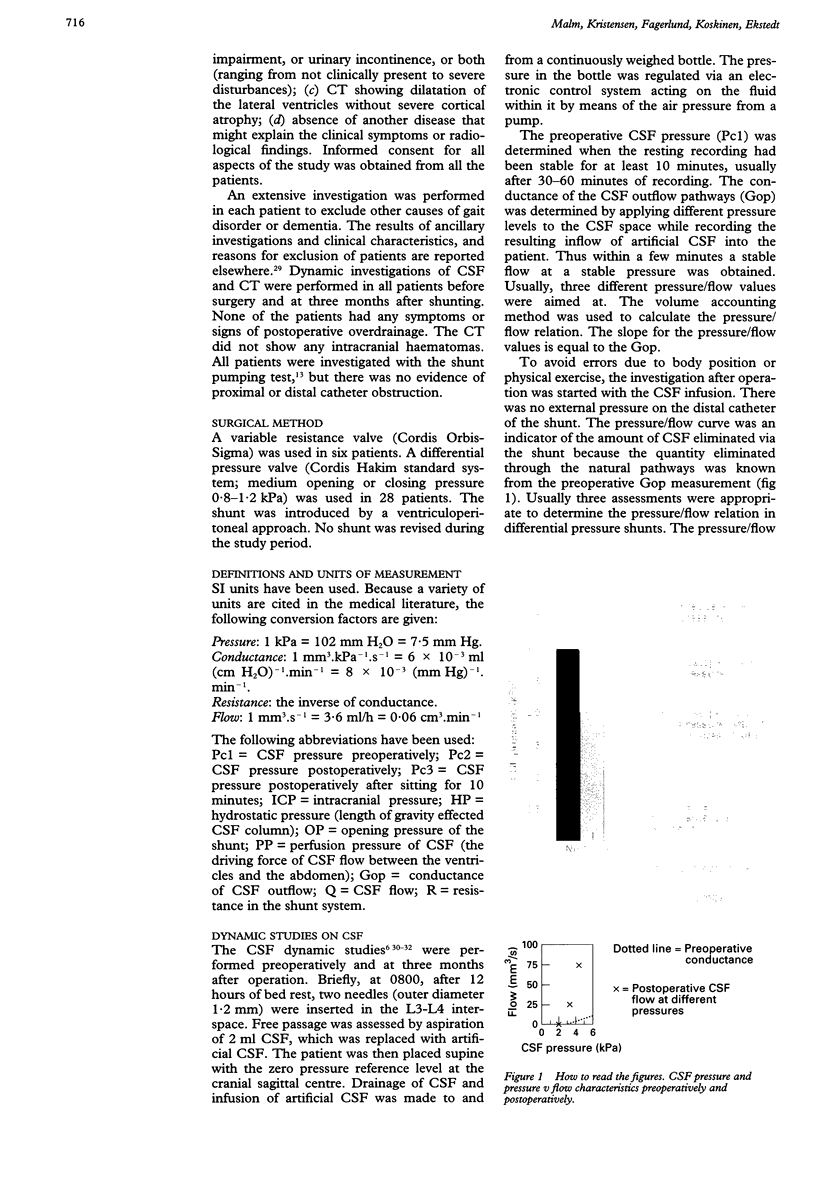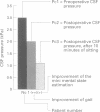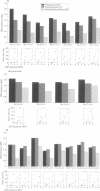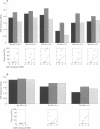Abstract
The objective was to assess CSF dynamics of different shunt constructions in patients with adult hydrocephalus syndrome and correlate these findings to clinical outcome, neuroradiology, and the specifications of the shunts provided by the manufacturer. Thirty four patients with idiopathic adult hydrocephalus (normal pressure hydrocephalus) syndrome were included in a prospective, consecutive case series. A differential pressure valve (Cordis Hakim standard system) was used in 28 patients and a variable resistance valve (Cordis Orbis-Sigma) in six. A constant pressure infusion method was used; CSF pressure and conductance were determined before surgery. Three months after shunt placement CSF pressure, the "pressure v flow" curve, and gravity induced flow were measured. There was no difference between mean preoperative and postoperative resting CSF pressures in patients with Hakim shunts. The opening pressures of the Hakim shunts were higher than the value proposed by the manufacturer. A pronounced gravity effect induced CSF flow and decrease of the CSF pressure. In functioning variable resistance valves, CSF dynamics normalised postoperatively. There was no gravity effect and the characteristics shaped "pressure v flow" curve was sometimes seen. Six patients (three differential pressure valves, three variable resistance valves) had non-functioning shunts. Four of these patients were improved after the operation but improvement was transient in three. In all patients, there was no relation between the width of the ventricles and clinical improvement or CSF pressure. In conclusion, the differential pressure valve system does not behave according to the specifications provided by the manufacturer. A decrease in CSF pressure in patients with this shunt was solely due to the effect of gravity. Eleven percent of the differential pressure valves and 50% of the variable resistance valves were non-functioning. In the functioning variable resistance valves, the antisiphon system seems to be effective.
Full text
PDF








Images in this article
Selected References
These references are in PubMed. This may not be the complete list of references from this article.
- ADAMS R. D., FISHER C. M., HAKIM S., OJEMANN R. G., SWEET W. H. SYMPTOMATIC OCCULT HYDROCEPHALUS WITH "NORMAL" CEREBROSPINAL-FLUID PRESSURE.A TREATABLE SYNDROME. N Engl J Med. 1965 Jul 15;273:117–126. doi: 10.1056/NEJM196507152730301. [DOI] [PubMed] [Google Scholar]
- Black P. M., Ojemann R. G., Tzouras A. CSF shunts for dementia, incontinence, and gait disturbance. Clin Neurosurg. 1985;32:632–651. [PubMed] [Google Scholar]
- Borbély K., Simkovics M., Paraicz E., Pásztor E. Scintigraphic study of cerebrospinal fluid shunts. Acta Neurochir (Wien) 1989;100(3-4):115–119. doi: 10.1007/BF01403597. [DOI] [PubMed] [Google Scholar]
- Børgesen S. E., Gjerris F. The predictive value of conductance to outflow of CSF in normal pressure hydrocephalus. Brain. 1982 Mar;105(Pt 1):65–86. doi: 10.1093/brain/105.1.65. [DOI] [PubMed] [Google Scholar]
- Chadduck W. M., Crabtree H. M., Blankenship J. B., Adametz J. Transcranial Doppler ultrasonography for the evaluation of shunt malfunction in pediatric patients. Childs Nerv Syst. 1991 Feb;7(1):27–30. doi: 10.1007/BF00263829. [DOI] [PubMed] [Google Scholar]
- Chapman P. H., Cosman E. R., Arnold M. A. The relationship between ventricular fluid pressure and body position in normal subjects and subjects with shunts: a telemetric study. Neurosurgery. 1990 Feb;26(2):181–189. doi: 10.1097/00006123-199002000-00001. [DOI] [PubMed] [Google Scholar]
- Costabile G., Probst C. Intrathecal infusion test and decrease in shunt revisions and infections. Neurochirurgia (Stuttg) 1988 Jul;31(4):134–135. doi: 10.1055/s-2008-1053919. [DOI] [PubMed] [Google Scholar]
- Czosnyka M., Maksymowicz W., Batorski L., Koszewski W., Czosnyka Z. Comparison between classic-differential and automatic shunt functioning on the basis of infusion tests. Acta Neurochir (Wien) 1990;106(1-2):1–8. doi: 10.1007/BF01809325. [DOI] [PubMed] [Google Scholar]
- Ekstedt J. CSF hydrodynamic studies in man. 1. Method of constant pressure CSF infusion. J Neurol Neurosurg Psychiatry. 1977 Feb;40(2):105–119. doi: 10.1136/jnnp.40.2.105. [DOI] [PMC free article] [PubMed] [Google Scholar]
- Fisher C. M. Communicating hydrocephalus. Lancet. 1978 Jan 7;1(8054):37–37. doi: 10.1016/s0140-6736(78)90378-1. [DOI] [PubMed] [Google Scholar]
- Fisher C. M. Hydrocephalus as a cause of disturbances of gait in the elderly. Neurology. 1982 Dec;32(12):1358–1363. doi: 10.1212/wnl.32.12.1358. [DOI] [PubMed] [Google Scholar]
- Folstein M. F., Folstein S. E., McHugh P. R. "Mini-mental state". A practical method for grading the cognitive state of patients for the clinician. J Psychiatr Res. 1975 Nov;12(3):189–198. doi: 10.1016/0022-3956(75)90026-6. [DOI] [PubMed] [Google Scholar]
- Foltz E. L., Blanks J. P. Symptomatic low intracranial pressure in shunted hydrocephalus. J Neurosurg. 1988 Mar;68(3):401–408. doi: 10.3171/jns.1988.68.3.0401. [DOI] [PubMed] [Google Scholar]
- Fox J. L., McCullough D. C., Green R. C. Effect of cerebrospinal fluid shunts on intracranial pressure and on cerebrospinal fluid dynamics. 2. A new technique of pressure measurements: results and concepts. 3. A concept of hydrocephalus. J Neurol Neurosurg Psychiatry. 1973 Apr;36(2):302–312. doi: 10.1136/jnnp.36.2.302. [DOI] [PMC free article] [PubMed] [Google Scholar]
- Frank E., Buonocore M., Hein L. Magnetic resonance imaging analysis of extremely slow flow in a model shunt system. Childs Nerv Syst. 1992 Mar;8(2):73–75. doi: 10.1007/BF00298443. [DOI] [PubMed] [Google Scholar]
- Graff-Radford N. R., Godersky J. C. Normal-pressure hydrocephalus. Onset of gait abnormality before dementia predicts good surgical outcome. Arch Neurol. 1986 Sep;43(9):940–942. doi: 10.1001/archneur.1986.00520090068020. [DOI] [PubMed] [Google Scholar]
- Greenberg J. O., Shenkin H. A., Adam R. Idiopathic normal pressure hydrocephalus-- a report of 73 patients. J Neurol Neurosurg Psychiatry. 1977 Apr;40(4):336–341. doi: 10.1136/jnnp.40.4.336. [DOI] [PMC free article] [PubMed] [Google Scholar]
- Hakim S., Adams R. D. The special clinical problem of symptomatic hydrocephalus with normal cerebrospinal fluid pressure. Observations on cerebrospinal fluid hydrodynamics. J Neurol Sci. 1965 Jul-Aug;2(4):307–327. doi: 10.1016/0022-510x(65)90016-x. [DOI] [PubMed] [Google Scholar]
- Hanson J., Levander B., Liliequist B. Size of the intracerebral ventricles as measured with computer tomography, encephalography and echoventriculography. Acta Radiol Suppl. 1975;346:98–106. doi: 10.1177/0284185175016s34611. [DOI] [PubMed] [Google Scholar]
- Howman-Giles R., McLaughlin A., Johnston I., Whittle I. A radionuclide method of evaluating shunt function and CSF circulation in hydrocephalus. Technical note. J Neurosurg. 1984 Sep;61(3):604–605. doi: 10.3171/jns.1984.61.3.0604. [DOI] [PubMed] [Google Scholar]
- Kristensen B., Malm J., Markgren P., Ekstedt J. CSF hydrodynamics in superior sagittal sinus thrombosis. J Neurol Neurosurg Psychiatry. 1992 Apr;55(4):287–293. doi: 10.1136/jnnp.55.4.287. [DOI] [PMC free article] [PubMed] [Google Scholar]
- Laws E. R., Mokri B. Occult hydrocephalus: results of shunting correlated with diagnostic tests. Clin Neurosurg. 1977;24:316–333. doi: 10.1093/neurosurgery/24.cn_suppl_1.316. [DOI] [PubMed] [Google Scholar]
- Martin A. J., Drake J. M., Lemaire C., Henkelman R. M. Cerebrospinal fluid shunts: flow measurements with MR imaging. Radiology. 1989 Oct;173(1):243–247. doi: 10.1148/radiology.173.1.2781015. [DOI] [PubMed] [Google Scholar]
- Nutt J. G., Marsden C. D., Thompson P. D. Human walking and higher-level gait disorders, particularly in the elderly. Neurology. 1993 Feb;43(2):268–279. doi: 10.1212/wnl.43.2.268. [DOI] [PubMed] [Google Scholar]
- Petersen R. C., Mokri B., Laws E. R., Jr Surgical treatment of idiopathic hydrocephalus in elderly patients. Neurology. 1985 Mar;35(3):307–311. doi: 10.1212/wnl.35.3.307. [DOI] [PubMed] [Google Scholar]
- Piatt J. H., Jr Physical examination of patients with cerebrospinal fluid shunts: is there useful information in pumping the shunt? Pediatrics. 1992 Mar;89(3):470–473. [PubMed] [Google Scholar]
- Pudenz R. H., Foltz E. L. Hydrocephalus: overdrainage by ventricular shunts. A review and recommendations. Surg Neurol. 1991 Mar;35(3):200–212. doi: 10.1016/0090-3019(91)90072-h. [DOI] [PubMed] [Google Scholar]
- Reilly P. L., Savage J. P., Doecke L. Isotope transport studies and shunt pressure measurements as a guide to shunt function. Br J Neurosurg. 1989;3(6):681–690. doi: 10.3109/02688698908992692. [DOI] [PubMed] [Google Scholar]
- Sainte-Rose C., Hooven M. D., Hirsch J. F. A new approach in the treatment of hydrocephalus. J Neurosurg. 1987 Feb;66(2):213–226. doi: 10.3171/jns.1987.66.2.0213. [DOI] [PubMed] [Google Scholar]
- Sainte-Rose C., Piatt J. H., Renier D., Pierre-Kahn A., Hirsch J. F., Hoffman H. J., Humphreys R. P., Hendrick E. B. Mechanical complications in shunts. Pediatr Neurosurg. 1991;17(1):2–9. doi: 10.1159/000120557. [DOI] [PubMed] [Google Scholar]
- Savader S. J., Savader B. L., Murtagh F. R., Clarke L. P., Silbiger M. L. MR evaluation of flow in a ventricular shunt phantom with in vivo correlation. J Comput Assist Tomogr. 1988 Sep-Oct;12(5):765–769. doi: 10.1097/00004728-198809010-00009. [DOI] [PubMed] [Google Scholar]
- Vanneste J., Augustijn P., Dirven C., Tan W. F., Goedhart Z. D. Shunting normal-pressure hydrocephalus: do the benefits outweigh the risks? A multicenter study and literature review. Neurology. 1992 Jan;42(1):54–59. doi: 10.1212/wnl.42.1.54. [DOI] [PubMed] [Google Scholar]
- Vassilouthis J. The syndrome of normal-pressure hydrocephalus. J Neurosurg. 1984 Sep;61(3):501–509. doi: 10.3171/jns.1984.61.3.0501. [DOI] [PubMed] [Google Scholar]
- Watts C., Keith H. D. Testing the hydrocephalus shunt valve. Childs Brain. 1983;10(4):217–228. doi: 10.1159/000120117. [DOI] [PubMed] [Google Scholar]
- Wikkelsø C., Andersson H., Blomstrand C., Lindqvist G. The clinical effect of lumbar puncture in normal pressure hydrocephalus. J Neurol Neurosurg Psychiatry. 1982 Jan;45(1):64–69. doi: 10.1136/jnnp.45.1.64. [DOI] [PMC free article] [PubMed] [Google Scholar]







